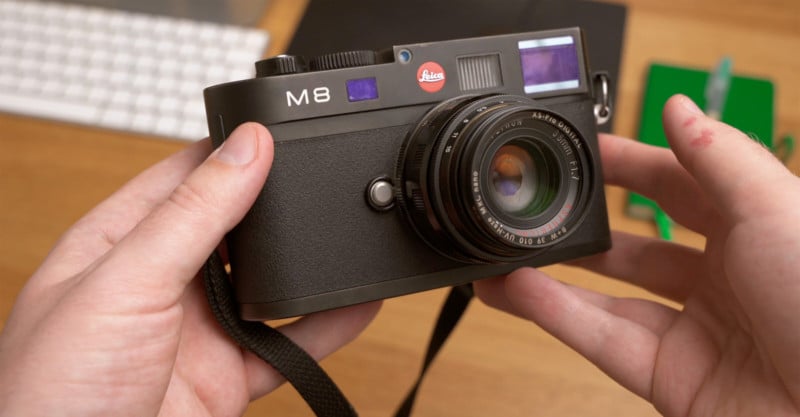9 Things That Make Leica Rangefinders Different from Other Digital Cameras
If someone would ask me what digital camera brand is the most different from all the others, I would definitely answer Leica. A couple of weeks ago I bought my first Leica rangefinder, after using virtually every other camera brand on the market.
1. No DOF preview in viewfinder
Since the viewfinder is a simple piece of glass pointing in the same direction as your lens, it does not exactly see what the lens sees. A side effect of this is that if you are using a fast lens — an f/1.4 lens, for example — the shallow depth of field will not be apparent in the viewfinder, only in the photo once you have taken it. This feels very weird in the beginning, but I got used to it pretty quickly.
2. Viewfinder framelines
Another effect of the viewfinder being decoupled from the lens you are using is that the image in the viewfinder is always the same focal length – around 24mm. To make your composition, you have to look at the frame lines inside the viewfinder, which will adjust automatically according to your focal length. A long lens will have a smaller frame line box in the viewfinder.
It is a bit strange to be able to see outside the frame, as you never get to do this in a DSLR or in other mirrorless cameras. But it can be very useful in sports or street photography, as you can easier get an overview and anticipate when a person will walk into the frame.

3. Rangefinder focusing
The focusing mechanism on Leica rangefinders is different from other digital cameras. A separate small rectangular window on the camera takes in light from a different angle than the viewfinder. This small rectangle is overlaid in the center of your viewfinder, and you will have to turn the focusing ring on the lens until the image in the small rectangle lines up perfectly with the rest of the viewfinder – then you know you have perfect focus on whatever is in the center of your frame.
To see this in action, and understand it better, watch the video above. It is actually a very quick and precise method to focus a manual lens — I like it!
4. Minimal menu
Minimalism and simplicity permeate the Leica experience. The menu in Leica rangefinders is very minimalistic. On my M8 it is only one page of options, as opposed to tens of pages put in a hierarchy, as in most other modern cameras.

5. Outstanding camera body design
I own digital cameras of all other brands, but I have to say that my Leica M8 is the most solidly built camera body I have ever held in my hands. It is probably because it is made all out of metal. Furthermore, everything is very tightly fitted and solid, as is the feeling in all the buttons. Every detail breathes quality and craftmanship. The camera body is pretty heavy for its size, but yet it doesn’t feel heavy in my hands. I think this is probably a lot of what you pay for in a Leica – great old school craftsmanship.
6. Analog feel
The Leica rangefinder feels very old school and low-tech. No autofocus. No electronic viewfinder. No indicators in the viewfinder except shutter speed and an arrow to indicate if you are over- or underexposed. The screen is not even on by default unless you want it to.
The Leica feels like using an old film camera, but you get a digital file instead of a film negative. Your job as a photographer is to just adjust framing, ISO, shutter speed, aperture, and focus — if the photo doesn’t come out good it is your own fault, not the camera. If you like the idea of this feeling, Leica might be something for you.

7. No video
The Leica M8, M9, and M10 do not have any video features at all. However, the rangefinders in the M240-series have a video feature.
8. Expensive as hell
A new Leica M10 will cost you around $7,500, which is pretty hefty. Even an old M8, which is their oldest digital model from 2006, will set you back around $1,200 in used condition. These prices are hefty, to say the least, and then I haven’t even mentioned the price of Leica brand lenses. There are however good cheap lens alternatives for the Leica M-mount, such as the offerings from Voigtländer.
9. Tiny lenses
Leica rangefinder lenses are very tiny and lightweight. For example, my Voigtländer 35mm f/1.7 lens is less than half the size of a corresponding lens for other full-frame cameras.
Conclusion
These were the 9 biggest differences I have noticed a couple of weeks after buying my first Leica. It is a very special experience compared to all the other cameras I own from Sony, Panasonic, Olympus, Canon, Ricoh, and Nikon.
I would summarize it as a more pleasant zen-like shooting experience, but not as powerful and versatile tool as many other (much cheaper) digital cameras.
About the author: Micael Widell is a photography enthusiast based in Stockholm, Sweden. The opinions expressed in this article are solely those of the author. Widell loves photography, and runs a YouTube channel with tutorials, lens reviews and photography inspiration. You can also find him on his website, Instagram, and Twitter.